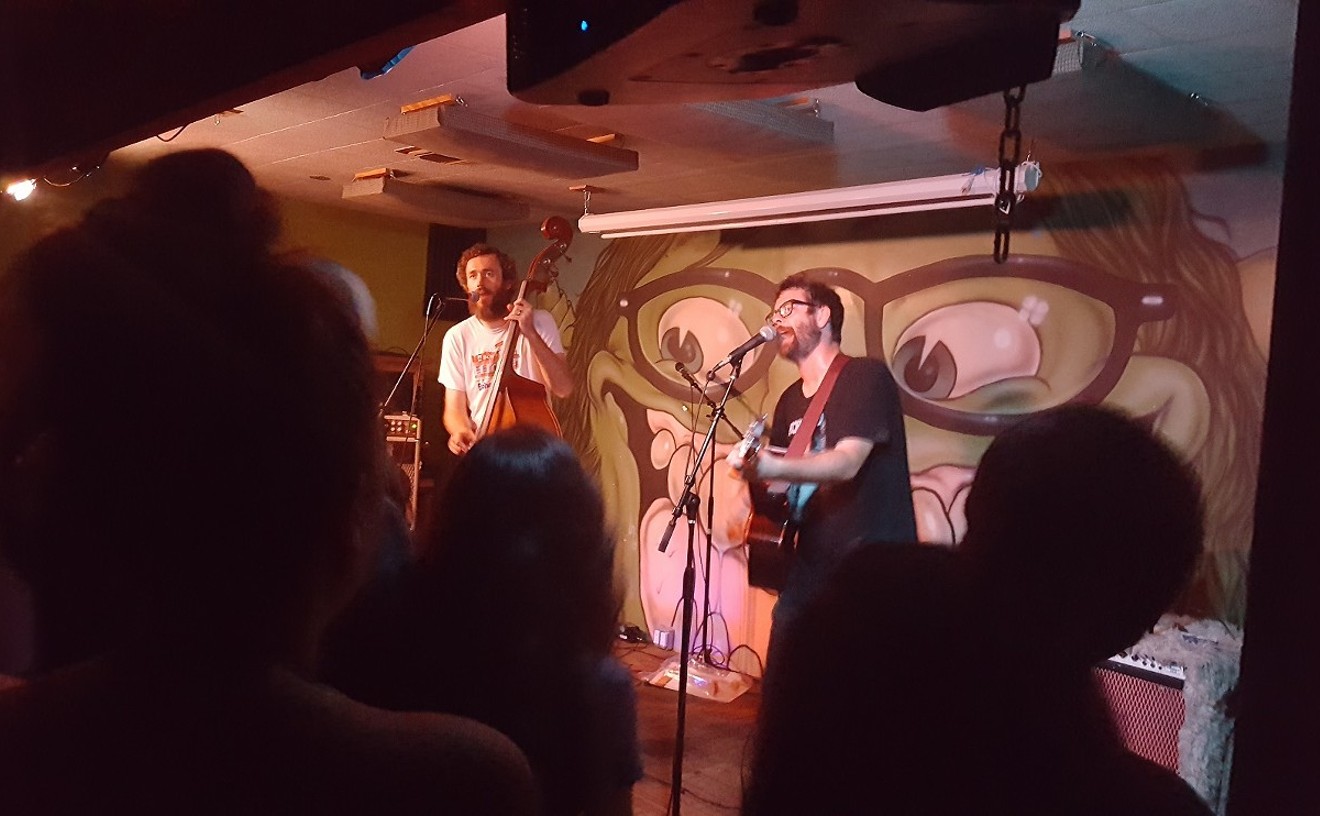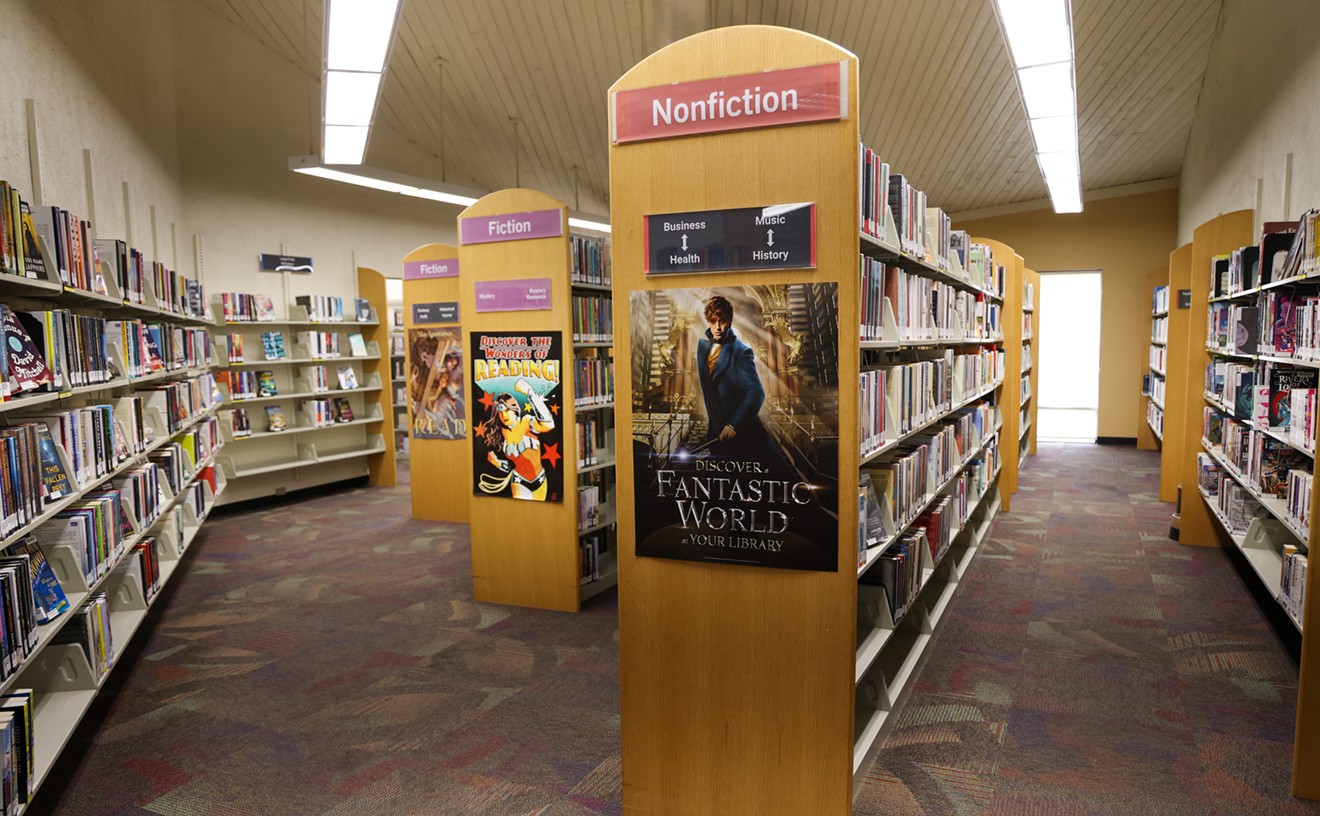Now Ahearn has become an unfortunate victim of a suffocating multicultural primness that amounts to an invidious form of censorship, an artist sacrificed to a priggishness in righteous clothing that avers that no one can speak for someone else--especially a white man in a nonwhite community, even though he's been an integral part of it for years.
Ahearn's work is on display at Arizona State University Art Museum in the exhibition "The South Bronx Hall of Fame and Other Realities: Sculpture by John Ahearn and Rigoberto Torres."
In the late Seventies, Ahearn was a 27-year-old, middle-class Anglo artist and part of downtown Manhattan's burgeoning art scene; he met Torres while working at Fashion Moda, an alternative gallery space in the South Bronx. Torres, who is Hispanic and originally from Puerto Rico, was 18 years old at the time and living in the neighborhood that ultimately became Ahearn's own.
Torres, whose experience with plaster began when he worked in his Uncle Raul's plaster statue factory, apprenticed with Ahearn, and later became his partner. The controversy over the men's work centered on subject matter. Some of their subjects are drug addicts or dealers. Some are street people; some are on welfare or unemployed. Others are just plain working folks trying hard to endure despite grinding poverty and crime-related violence. And most are either black or Hispanic, like the vast majority of the people living in the South Bronx or any other large, impoverished metropolitan area.
But from the work in this show, some of which appeared in a larger, 1991 retrospective at the Contemporary Arts Museum in Houston, you could never tell that the people Ahearn and Torres have immortalized in handpainted plaster are gritty survivors of a nightmarish, urban no man's land. Ahearn and Torres have unconditionally accepted the realities of the South Bronx. That's why their sculptures work so well. These are not songs of praise offered up solicitously for the souls of the downtrodden. They are effigies of real, breathing people the artists know, caught in the act of being themselves--of being quintessentially human. Therein lies their power and effectiveness: These figures, pulsating with an in-your-face energy that makes them seem even larger than life, transcend the treeless, concrete hell from which they have emerged.
The Ahearn and Torres sculptures on display are solar systems away from the ghostlike, environmental tableaux of pop sculptor George Segal, who also cast people in plaster for his life-size, narrative scenarios. They do not share the sense of isolation and loneliness of Segal's frozen vignettes, peopled with white statues that Segal leaves rough and unfinished, or the bizarre hyperreality of Duane Hanson's photo-realistically painted plaster archetypes, figures that seem like they belong in some wax museum.
The work of Ahearn and Torres celebrates, in a direct and unromanticized way, the people they are casting and the tightly knit community from which those people come, rather than something outside of those persons. And their casting process involves a good deal of street theatre.
"Our work is conceptual to a degree, but more related to performance because it's done with public participation," explained Ahearn during his visit to Phoenix. "It's more related to social activism because it involves communities of people and networking with a lot of people at once. We never use people as models. "Unlike Segal and Hanson," said Ahearn, "these figures come out of the core experience of making them and knowing the person. Segal or Hanson will find someone interesting and have them play a role, which is not necessarily what they are in real life. I think that, at some point in the process, I try to feel what it's like to be this person."
From their streetside studio on Walton Avenue, Ahearn and Torres lure potential participants by hanging painted plaster busts on the building's outer walls, although for years they often conscripted willing friends and family as subjects. Now, curious passers-by will often stop and ask about the pieces, wanting to know how they can get one made of themselves. The sculptors usually offer to make a cast for someone, if the person agrees to sit for the casting. The casting is often done in full view of the milling crowd that collects to watch the process, which commands ultimate trust from both the artist and the sitter. "The most difficult aspect of casting," Ahearn said, "is the person you are working with. They have to trust you, but, in turn, you have to trust them--that they're going to come through, in a sense. That's the hardest thing--to psych this out with someone so that everything is going to come out right."
Being cast is definitely not for the claustrophobic. Photographs of the procedure bring to mind Egyptian mummification, but the results bring the casted to life, instead of preparing them for the afterlife. For 20 minutes or so, the sitter, with straws in his or her nose, lies flat while Jeltrate, a material used to make dental impressions, is smeared completely over face, hair and torso; sometimes, the entire body is cast. Quick-setting plaster bandages are next applied as a backing for the mother mold, from which the final plaster cast is made. The final sculpture is then refined, and painted by either Ahearn or Torres, whose painting styles and compositional methods are as distinctive as the artists themselves. Ahearn's expressionistic approach to the final painting employs strong, mottled color, while Torres' painting is flatter and more suggestive of the type of painting found on the religious statues churned out by his uncle's factory for the neighborhood botanicas.
Children as young as 6 or 7 routinely sit through the procedure, as did one 7-year-old named Thea during a workshop Ahearn has been conducting at the Boys and Girls' Club of Tempe in conjunction with the ASU show.
"Slowly, we were able to cast younger kids," said Ahearn, "but when Robert did one of his 2-year-old daughter [who appears as a floating mermaid in the show], he just left me in the dust . . . this is out of my range. I wouldn't even know where to start." (Torres' secret was to cast the baby in sections, while family members held and distracted her.) Busts, as well as full figures, of parents, lovers, shopkeepers, children playing or mugging, and other neighborhood fixtures have been used by Ahearn and Torres to create three-dimensional murals on building walls throughout the South Bronx; creating the murals draws as big a crowd as the individual casting does. For almost 15 years, Ahearn and Torres have been known and respected in both the often fickle art world and their own South Bronx neighborhood. Both equally respect the neighborhood. But that didn't seem to prevent Ahearn from becoming an unwitting sacrificial lamb on the altar of misguided multiculturalism and political correctness two years ago. In the face of charges that they had used racist stereotyping and portrayed negative role models, leveled by two vocal members of New York's black community (who, interestingly enough, did not even live in the South Bronx) and other residents of the neighborhood, Ahearn removed three bronze statues he had done of neighborhood people. He removed them only three days after they had been set in place in a traffic triangle in front of the South Bronx's 44th Precinct police station. Long before they were ever put on their pedestals, the bronzes (including "Raymond and Toby," a fiber-glass cast of which can be seen in the museum's show) had been commissioned, approved and funded by the Percent for Art Program of the New York City Department of Cultural Affairs.
Ahearn still appears hurt when he speaks of the incident, during which the artist was criticized for making Raymond, who, in fact, has a problem with drugs, look like a drug dealer by casting him in a hooded sweat shirt, part of some unspoken uniform code of drug dealers in the South Bronx.
"The statues lacked any semblance of idealism. People felt either I was making a joke of somebody or maybe just promoting stereotypes," Ahearn said.
"What's politically correct to one person is incorrect to someone else," said Ahearn. "If you're not used to seeing [the statues], they could be shocking. These were up on pedestals looking down. I think a lot of the neighborhood wasn't really ready for this. . . . In retrospect, I made a mistake in what I had done; not only was it not working, but it threatened to erupt into a really bad scandal. What could have happened didn't happen because it was nipped in the bud. . . . [T]he media would have jumped on it; I didn't want to test the waters to see what would happen." John Ahearn is now at a crossroads in his career as a result of the controversy. "When I knew a lot of people there and was happy about work, the block struck me as being the center of the universe," he said. "It was the most wonderful spot on Earth with the warmest, nicest people and more activity going on than anywhere else . . . I thought it seemed very special--special for me to be there. . . ." Now he doesn't know whether he will continue to live there.
Robert Torres has long since moved from the neighborhood he grew up in; last December, he suffered a severe asthma attack, which has temporarily left him with double vision, blinding headaches and memory loss, conditions that make it hard for him to work.
And the neighborhood from which both artists drew their inspiration? It's pretty much the same. The only thing different is the absence of three powerful bronze statues of real people who, like it or not, live there.










